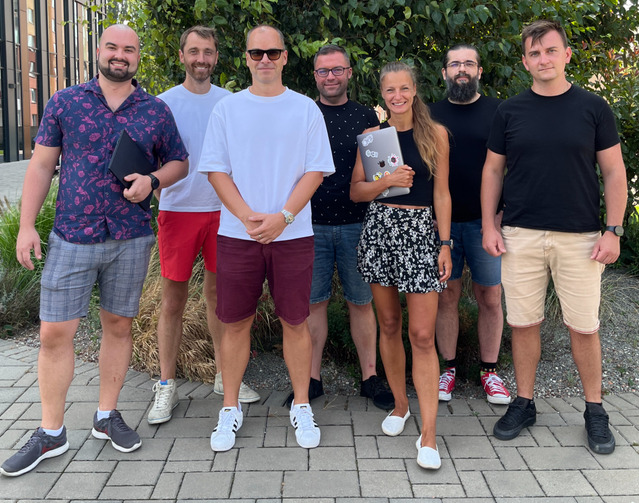Benefits
30%
reduction in overall costs99%
uptime achieved post migration22%
YoY revenue growth achieved18%
user growth YoY, serving 13 million users seamlesslyOverview

About Crossuite
Founded in 2007, Crossuite is a scale-up actively transforming healthcare with fast and intuitive online tools for both patients and healthcare professionals so that they can cooperate to increase the quality of the provided medical services.
Opportunity | Migrating to Amazon EKS to Meet Growing Demand
Founded in 2007, Belgian health-tech scale-up Crossuite is a pioneer in cloud-based practice-management solutions. Its all-in-one solution offers electronic medical records, financial operations, patient portals, automated communications, scheduling, and a mobile app.
The solution is designed to streamline workflows and enhance patient interactions and is widely adopted in the healthcare industry. As a result of its significant growth, Crossuite now serves over 10,000 health practitioners and supports more than 13 million patients across over 23 countries.
Originally built on on-premises infrastructure, Crossuite managed its Kubernetes clusters manually. This process was time-consuming and diverted developers from more critical tasks, such as enhancing the user experience, improving system security, and developing new features. The solution, which is designed for healthcare professionals, saw traffic spikes during business days and quieter periods during evenings and weekends, complicating cluster management.
The need to dynamically adjust to varying loads for optimal performance and resource efficiency necessitated a robust, flexible infrastructure. “We don’t want to run at full capacity when we don’t have to,” says Tomas Madliak, cloud technology consultant at Crossuite. Crossuite faced challenges with its on-premises infrastructure, including manual Kubernetes cluster management that consumed developer time and hindered focus on innovation.
In 2021, Crossuite recognized that modernization was the key to future growth. “We wanted to become more agile and resilient and to future-proof our critical applications by being cloud based,” says Madliak. Meeting scalability needs for the growing demand of the solution was crucial, with a major focus on designing an architecture to accommodate future user-base growth.
Crossuite worked alongside AWS to set up a proof of concept, starting with lifting and shifting its legacy infrastructure to Amazon Elastic Kubernetes Service (Amazon EKS), a managed Kubernetes service. AWS recommended testing automatic scaling using Karpenter, an open-source Kubernetes cluster automatic scaler, alongside Amazon EKS, to establish a dynamic infrastructure capable of scaling on demand
Solution | Achieving 99.9% Uptime While Scaling to Millions of Application Users
As Crossuite onboarded more clients, it aimed to scale effectively, reduce compute costs, and free up its development teams. The goal was to enhance its infrastructure without impacting the application, focusing instead on monitoring, testing, and refining the setup during migration.
Crossuite used the AWS best-practices framework for migrating to Amazon EKS, covering external databases, APIs, third-party services, and necessary network adjustments. It was crucial to adapt security policies, identity and access management roles, and compliance checks to AWS using the robust security controls of Amazon EKS.
Crossuite designed its architecture with scalability and high availability in mind. Using Terraform, the team provisioned the Amazon EKS cluster, while GitLab’s continuous integration and deployment pipelines streamlined application deployment onto the Amazon EKS environment.
They enabled Horizontal Pod Autoscaling (HPA) for customer-facing services to ensure dynamic scaling. Crossuite configured the ingress layer with an AWS Application Load Balancer, which provided flexible routing and load distribution. For the backend, the team used AWS Relational Database Service (RDS) PostgreSQL, taking advantage of its scalability and reliability.
The company used observability and monitoring tools such as Amazon CloudWatch—a service that monitors applications, responds to performance changes, optimizes resource use, and provides insights into operational health. Thus, Crossuite was able to track application performance and health during and after the migration.
With this level of observability, Crossuite confidently migrated massive amounts of data quickly and switched production traffic to Amazon EKS. “We wanted to be validated by AWS solution architects so that we didn’t miss anything,” says Lukas Pollak, DevOps and server reliability engineer at Crossuite. “We got really useful advice from AWS.”
Crossuite seamlessly switched its new Amazon EKS clusters to production in May 2024. This migration removed many manual tasks for the development team, such as spinning up new nodes, manually configuring the scaling policies and mechanisms, managing complex networking and redundancy planning across multiple servers, and redistributing pods across them.
The company has multiple pods running on Amazon EKS, and it adopted Karpenter to improve application availability and cluster efficiency by rapidly launching rightsized compute resources in response to the changing application load. Previously, it took the Crossuite team around 15 minutes to spin up a new node. Now, using Karpenter, this can be done automatically in less than 2 minutes—that is, about an 86 percent reduction in time. “It’s seamless for us,” says Madliak. “Plus, the huge flexibility in this setup prepares us for the future.”
Crossuite also established a continuous integration and continuous deployment pipeline on AWS to roll out cluster updates with one click. “Our team can now focus more on development and innovations, not maintenance,” says Pollak. “The overall benefit is a more robust, efficient, and cost-effective solution.”
Through this migration and modernization, Crossuite has improved performance and availability. When activity peaks, its solution can automatically scale to meet demand without affecting the experience of millions of users. The company has achieved 99.9 percent uptime while reducing latency for its customers. “We can now release code to production anytime without affecting site performance, which was a challenge before,” says Madliak. “On AWS, there’s no service disruption with new releases. That brings us closer to 100 percent availability.”
By migrating to Amazon EKS and Karpenter, Crossuite also reduced costs. Using Karpenter’s node lifecycle management in combination with cost-optimized instances, Crossuite reduced its overall costs by 30 percent compared with its previous solution. “Cost reduction has been a huge gain from this migration,” says Pollak. “As a scale-up, we need to focus on cost efficiency.”
Outcome | Increasing User Adoption by 18% and Revenue by 22%
After modernizing its cloud architecture on AWS, Crossuite has significantly improved the stability, performance, and scalability of its eHealth application. The company now supports a growing number of medical professionals, achieving an 18 percent year-over-year increase in user adoption without compromising application performance. Availability on AWS has greatly increased compared with the on-premises setup. With 22 percent year-over-year revenue growth, the solution continues to expand its reach and impact. With ongoing enhancements to its features and performance, Crossuite remains at the forefront of medical-practice-management solutions.
“There’s always pressure to move quickly, especially as a scale-up, but with support from the AWS team, we had enough time to modernize right. Planning and support were key to our migration" says Pollak. As Crossuite continues to innovate and expand, it remains committed to leveraging AWS services to maintain its competitive edge and deliver exceptional value to its growing customer base.
Architecture Diagram

On AWS, there’s no service disruption with new releases. That brings us closer to 100% availability.
Tomas Madliak
Cloud Technology Consultant, CrossuiteCrossuite Team

AWS Services Used
Get Started
Did you find what you were looking for today?
Let us know so we can improve the quality of the content on our pages